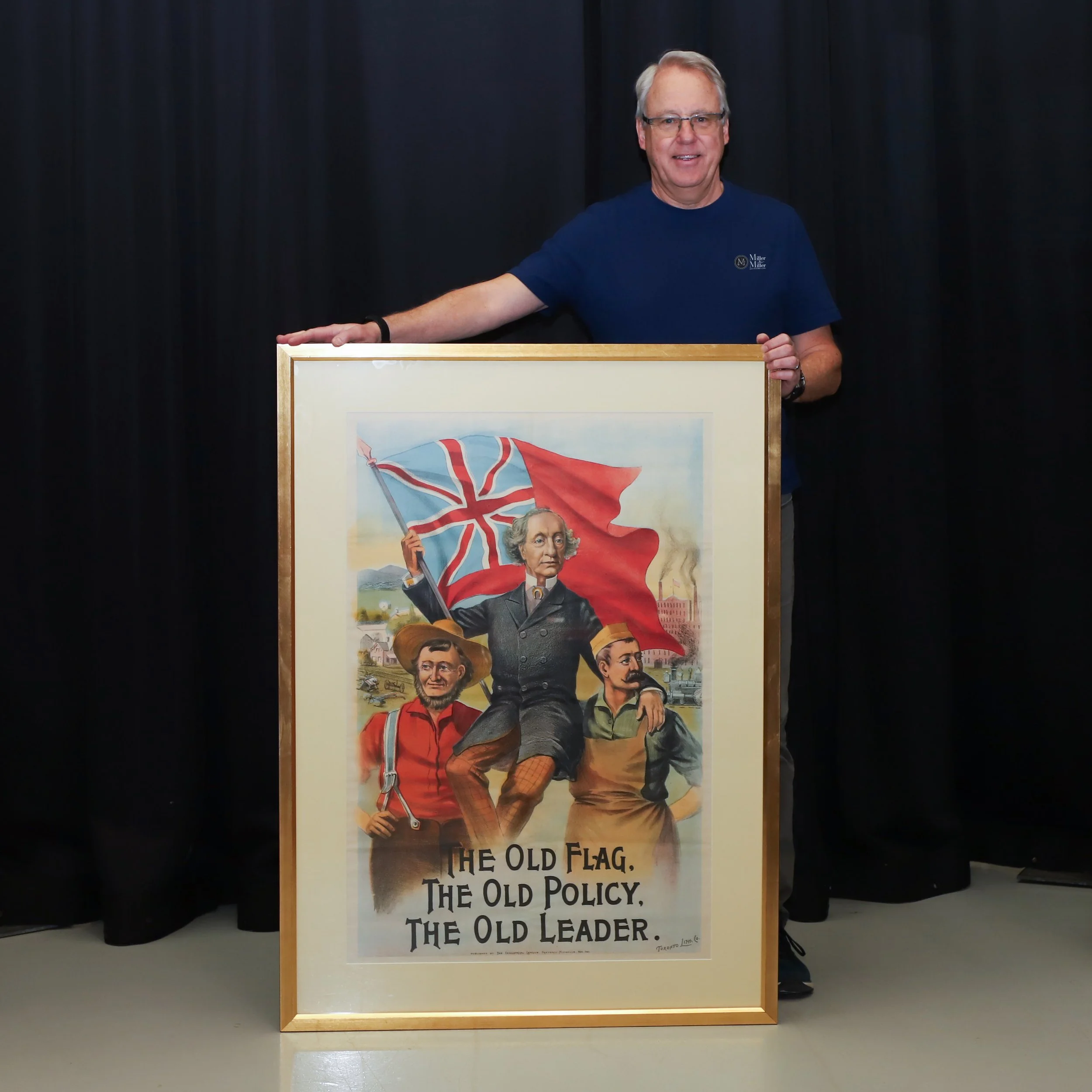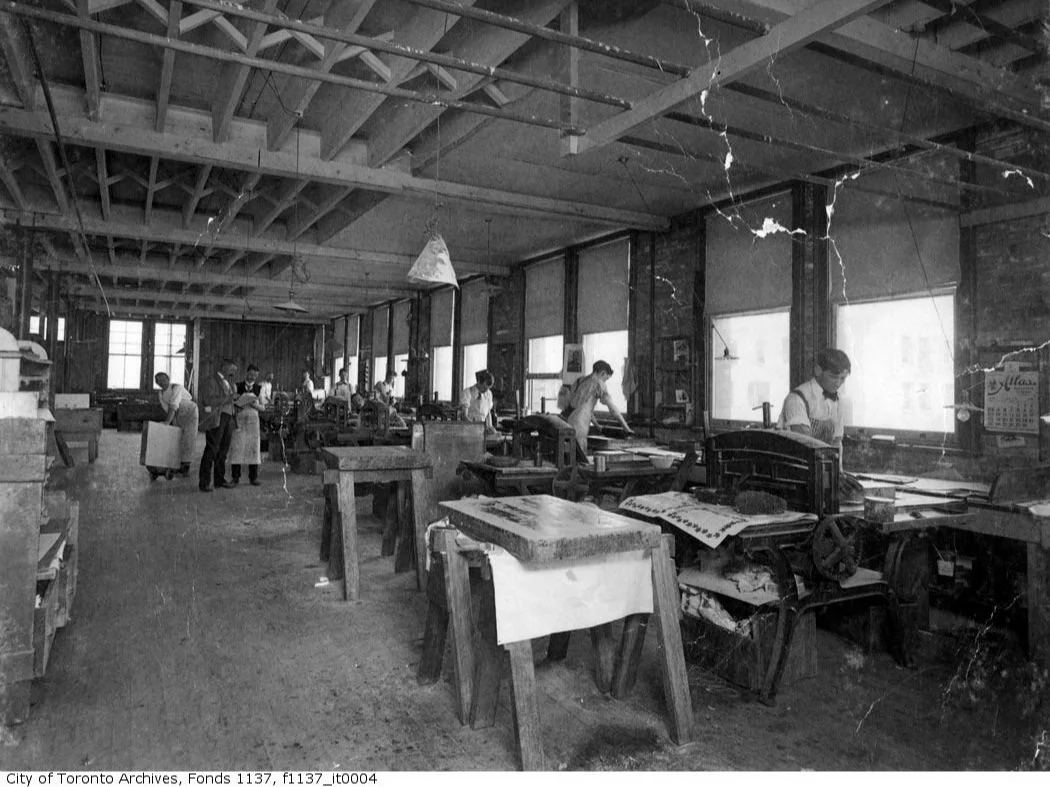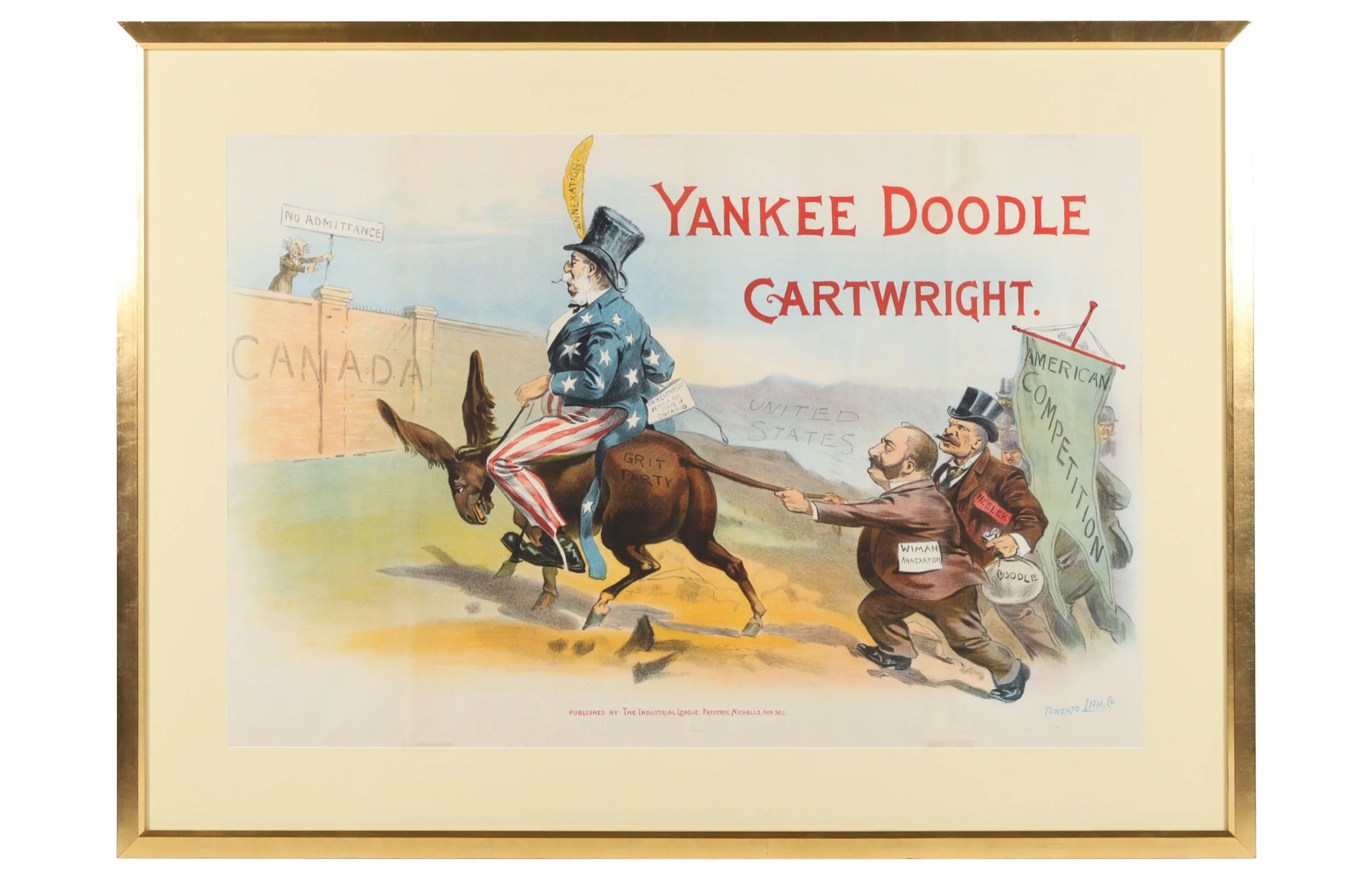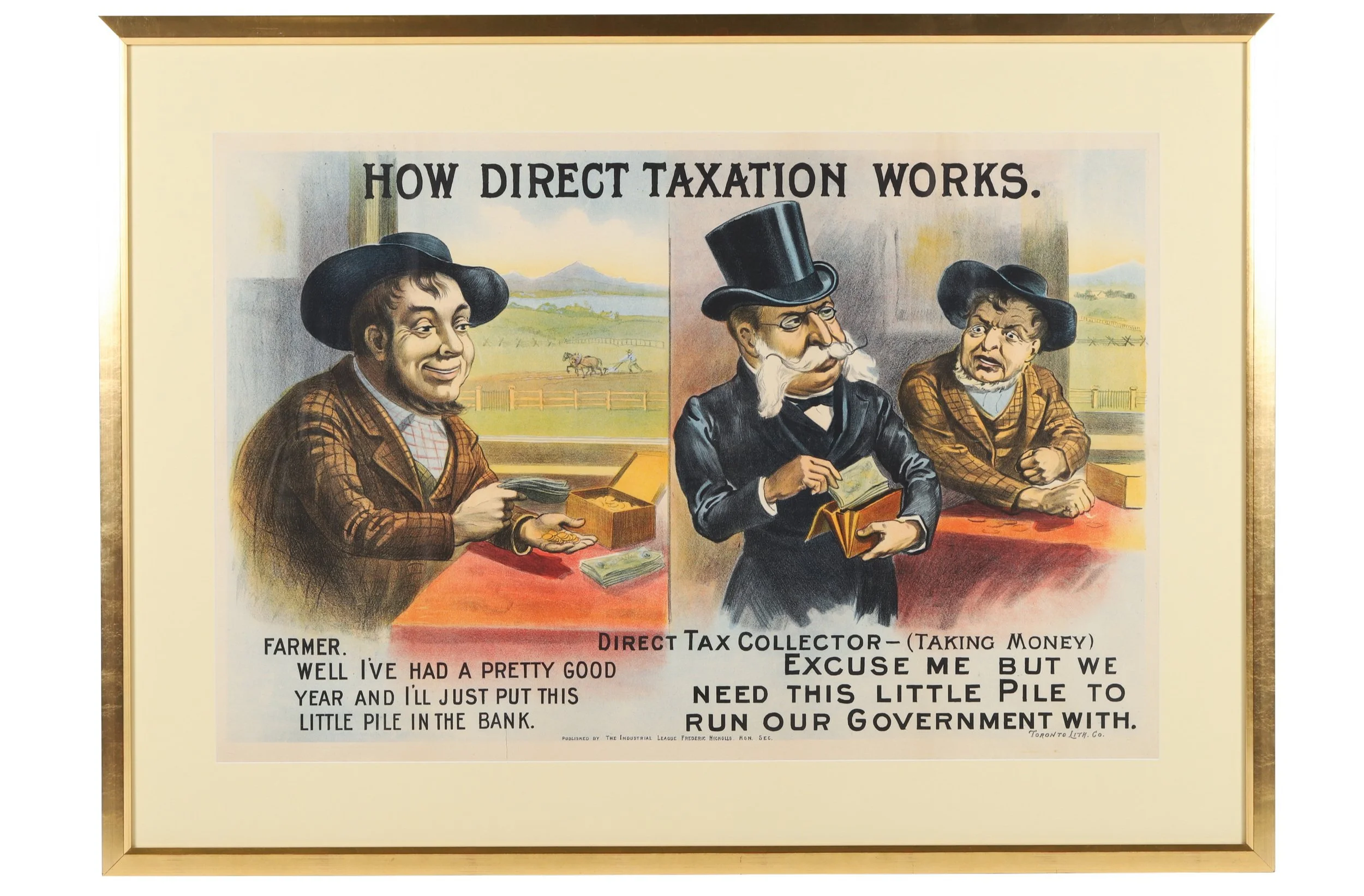The art of persuasion: Lithographs in politics
Five 1891 Canadian election posters come to auction
Miller & Miller team member Klaas De Witte holds the Conservative Party of Canada ‘The Old Flag, The Old Policy, The Old Leader’ Poster offered as lot 261 in the April 13th auction of Advertising, Canadiana & Historic Objects.
In the early months of 1891 Canada stood at a crossroads, poised between the past and future. The completion of the Canadian Pacific Railway in 1885 sparked a period of significant change reflected in economic growth and national unity. The air was thick with a sense of hope and possibility, as Canada, still in its formative years, sought to establish an identity on the world stage. The decision of electing a new prime minister became pivotal in shaping the future of the nation.
The protection of Canada's budding national identity stood at the forefront of the election. The campaigns had evolved into a contest of ideologies between the Conservative Party, led by five-term Prime Minister Sir John A. Macdonald, and the Liberal Party, led by Wilfrid Laurier. Central to the debate was the issue of free trade and the concern that Canada would become another American state. In a time before social media campaigns and television commercials, political strategists had to employ a bit more creativity. Eye-catching lithographed posters became a cornerstone to persuasion and victory in the 1891 election. Featuring engaging visuals and stirring messages, they provoked discussion and swayed public opinion. At the top, the large and colourful chromolithographic images rendered by the Toronto Lithographing Company played a pivotal role in the Conservative Party's campaign, and ultimately Sir John A. Macdonald's sixth victory.
The Toronto Lithographing Company, founded in 1878, was a major contributor to the history of printing and graphic design in Canada. The company became known as Canada’s largest and most advanced lithograph company, producing a variety of books, maps, posters and other printed materials. According to the Canadian Encyclopedia, the company employed a number of prominent artists, including Henri Julien, W.D. Blatchly, C.W. Jeffreys, and William Bengough—younger brother of the brilliant political caricaturist J.W. Bengough, who founded the satirical periodical Grip in 1872. Several of the Grip’s staff went on to form the famous group of Canadian landscape artists known as The Group of Seven.
The Lithography Department at the Toronto Lithographing Company in 1898. The Macdonald campaign lithographs were created at the location prior this one (13 Jordan Street, Toronto), which was destroyed in a fire in 1895. Source.
The lithographic presses at the Toronto Lithography Company in 1898. Source.
Leading up to the 1891 election, The Toronto Lithographing Company was hired by the Toronto Industrial League (a political organization associated with the Conservative Party) to create the election posters for Sir John A. Macdonald's campaign. This collaboration between a governmental body and an art house set a precedent for official propaganda production, a practice that continues today.
Miller & Miller is pleased to offer five original campaign posters from this 1891 collaboration as part of the April 13th auction of Advertising, Canadiana & Historic Objects. They provide a window into the political friction points that mark Canada’s growth as a nation.
The posters achieve the campaign’s goal of portraying the Liberal Party as pro-American. One example, offered as lot 258 in the sale, is the “Laying Out the Grit Campaign” poster. It depicts Wilfrid Laurier, Richard John Cartwright, and other Liberal Party members surrounding a table headed by US President Benjamin Harrison. They are coordinating plans for the “State of Ontario” on a map of the “Canadian States,” predicting a gloomy future for Canada should the Liberal Party win. The term "Grit" is a colloquial name for the Liberal Party, derived from "Clear Grit," a faction within the party in the 1850s known for its reformist and democratic ideals. The poster, along with the others offered in the sale, is marked, "Published by the Industrial League, Frederic Nicholls, Hon. Sec.", in the bottom margin, and "Toronto Lith Co," at the bottom right.
The Conservative Party of Canada 'Laying Out the Grit Campaign' Poster is offered as lot 258 in the April 13th auction.
In addition to his appearance in the "Laying Out the Grit Campaign" poster, prominent Liberal politician Richard John Cartwright is depicted unfavourably in several other campaign images. Cartwright was a staunch supporter of free trade, a policy that was deeply opposed by the Conservatives, who believed it would harm Canadian industries and lead to economic dependence on the United States. The “Yankee Doodle Cartwright” poster (lot 259), for example, shows Cartwright riding a donkey, steered by its tail by American competitors. This image aimed to ridicule the concept of free trade and suggest that Cartwright was a puppet of US trade interests.
The Conservative Party of Canada 'Yankee Doodle Cartwright’ Poster is offered as lot 259 in the sale.
The “The Way He Would Like It” poster (lot 260) portrays Cartwright as a slave trader seeking to sell away Canadian assets to the United States. It’s an excellent example of early Canadian political fear-mongering being employed to warn against the dangers of free trade with a rather devious-looking version of Uncle Sam.
Cartwright makes another appearance in the “How Direct Taxation Works” poster (lot 257), where he greedily seizes the profits of a hard-working Canadian farmer. This image is meant to warn against the high costs of operating a large Liberal Party government.
The fifth poster included in the sale gives Cartwright a break, instead featuring a stoic Sir John A. Macdonald supported on the shoulders of two contented Canadians. His official campaign slogan reads, “The Old Flag. The Old Policy. The Old Leader.” This campaign angle encouraged voters to embrace tradition and protectionism by re-electing Macdonald for his sixth term. While this effort proved successful, the prime minister would sadly pass away just three months after his victory. This iconic political poster is an important marker of Canada’s history as a nation.
The Conservative Party of Canada ‘The Old Flag, The Old Policy, The Old Leader’ Poster is offered as lot 261.
These remarkable lithographs offer a glimpse into Canada’s political past. In this era, political marketers relied heavily on the skills of artists and illustrators to convey their messages. Today, amidst our many modern conveniences, political campaigns often lack artistic depth. Despite this decline in creativity, smear campaigns surrounding high taxation, foreign trade, and national identity persist. The success of Macdonald's 1891 campaign begs the question: should modern political marketers get back to the ‘drawing’ board?
Story by Tess Malloy
Tess is a freelance writer and history enthusiast who enjoys unearthing interesting stories about remarkable people and objects. Tess has written for The Miller Times for six years.
SALE INFORMATION:
Advertising, Canadiana & Historic Objects
Featuring the Greg Hisey Collection
April 13, 2024
9am EST








